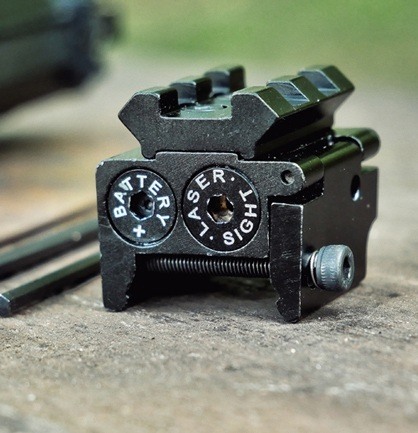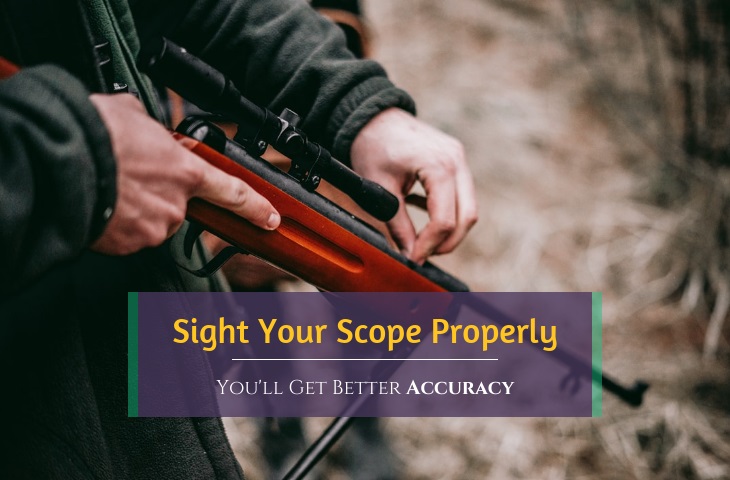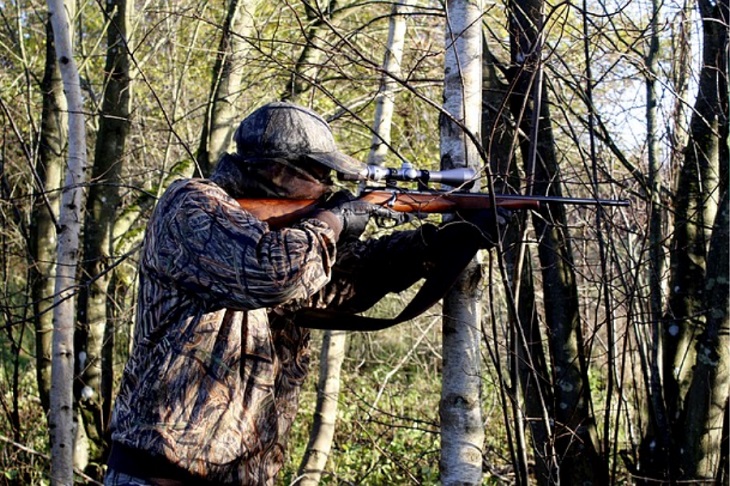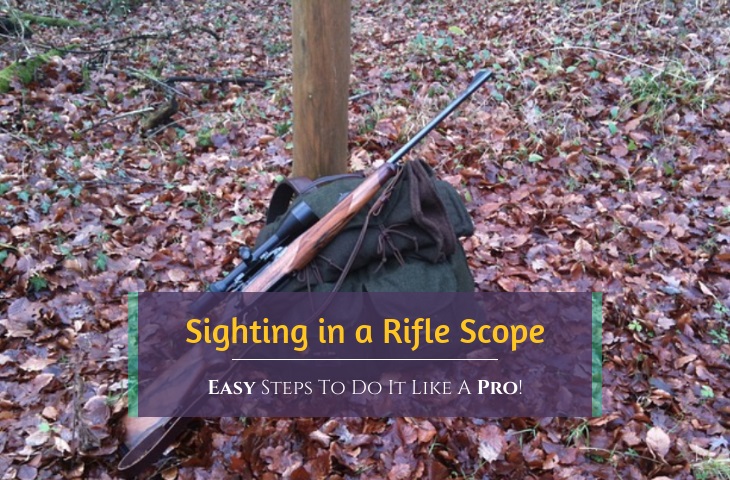It’s unimaginable to think of a responsible, ethical hunter without a sufficiently sighted rifle. Learn how to sight in a rifle scope like a pro with these steps and tips.
This post provides basic guidelines, including proper set up and mounting, bore sighting (with and without a laser), and how to zero in your rifle scope.

“I'm learning to hunt with rifles, because if you think about it, hunting gets you the healthiest meat - organic, free-range food. It's a totally yuppie spin on what I thought was kind of a redneck occupation.”
- Sarah Wayne Callies -
Whether you are hunting black bear, whitetail deer, red stag, Cape buffalo, or any other game animal — or simply doing some target practice — it is paramount that you adequately prepare your tools for the task ahead.
One thing you should definitely do is to make sure your scope is sighted and zeroed in correctly so you can place your shot appropriately, at the range you want it to shoot.
Is sighting in a rifle scope really important?, you may ask.
We believe (as do all true gunsmiths) that it’s unimaginable to think of a responsible and ethical hunter without a sufficiently sighted rifle. Unlike adjusting binoculars for a clear view, if your scope is out of focus, even if you are a great marksman, it's unlikely you'll hit what you are aiming for.
Your goal as a hunter is to have appropriately placed shots that give you a quick and ethical kill. And of course, not miss!
So, yes, it is absolutely necessary to sight in a rifle.
Sighting-in basically means aligning the reticles of the scope with the bore of the rifle. This adjustment is meant to help you determine the place where the shot will hit at a known distance.
The process of sighting in a scope is something that all hunters, or rather those who want to become avid hunters, have to learn. A rifle that is not correctly sighted in will make it quite difficult for you to hit and shoot your prey. While this might be an easy process for some, it might prove really difficult for others.
But practice makes perfect! Not to worry though as we are going to show you the quickest and simplest way on how to sight in a Scope and be ready for the fields.
In addition to our instructions, we’ve collected some videos along the way — to save you the time of searching yourself. As they say, a picture is worth a thousand words, but a video tutorial can be really help you understand those words!
Quick Links - Sighting in a Rifle Scope FAQS
In this article we hope to answer the most frequently asked questions about how to sight in a scope on a rifle. Want to go directly to a question? Click the link.
Do keep in mind that there are many techniques to zero in and sight rifles, and each gunsmith has their own style.
How to Mount & Sight in a Rifle Scope Like a Pro
Before you start the process of sighting in your rifle scope, make sure it is appropriately mounted and adjusted. Then, ascertain what distance you would like your rifle to be sighted in to. We suggest you go with 50 or 100 yards.
If you intend to zero it at a longer distance, for instance 200 or 300 yards, then you can first perform the initial process at a shorter distance. Once on paper, adjust your scope to obtain your longer-range zero.
Once you have your scope mounted properly, you're ready to get to sighting.
Whether you're game hunting or shooting targets, sighting in your scope should be done at least once a year.
Video: Steps for mounting a new rifle scope [Expert Tips from Pro Hunter Randy Newberg]
Tutorial: Basic Steps for a Rifle Scope Mount | Courtesy of Randy Newberg
Step 1: Set Up Your Scope
So, you have mounted your scope on the rifle, now double check to ensure the scope is firm with rings tightly fastened to the base. The scope should not have any wiggle whatsoever.
The next step is to readjust the reticle on the scope. It is important that the crosshairs are in line with where the shooter is at. Do this by pointing your scope at a solid background (such as the sky). Then turn away from the scope for some seconds at a far-off object as you focus your eyes on the object.
Now, look through the scope instantly, then look away again. So, how was the reticle? Was it in perfect focus, or it was somehow blurred?
If it’s blurred, look for the diopter adjustment on your scope and twist it. The diopter adjustment is found at the end, closer to the shooter. Keep adjusting until the reticle is well focused and clear.
Step 2: Bore Sight Your Rifle
Video: Easy Way to Bore Sight Your Rifle [NSSF Gunsmith Mitch Schultz]
Tutorial: Quick & Easy Bore Sighting Method | Courtesy of National Shooting Sports Foundation
Bore sighting is done before shooting the rifle. There are many ways to do this, but here are the general guidelines.
First make sure the barrel is unobstructed and the rifle is not loaded. At the range, ensure your target is set at 25 meters/yds and 100 meters/yds. Secure the rifle in a rest pointing downrange. This can be on sandbags or your hunting bag, in a bipod, using a vice, or any other method that can hold it steady as you sight in.
Video: Boresighting Your Rifle Without a Boresighter
Tutorial: How to Boresight without a Boresighter | Courtesy of Outdoor Life
Note that none of the parts of the rifle should rest on a stiff surface.
In case you have a bolt-action scope rifle, remove the bolt and then look down the bore while aligning it with the target. Fine-tune the rifle stand to allow the 100-yard target to be centered in your view as you look through the breech end.
Adjust the scope until the cross-hairs are in line with the same object. Your scope rifle has now been bore-sighted to 100 yards.
Using a Laser to Bore Sight a Rifle Scope

MCG Tactical Laser Sight - Developed by Weapons Expert
Take note that you can as well use a laser boresighter to execute the same task as long as it is able to fit in the compartment of the rifle.
The end result is the same though: to guarantee that the scope reticle is aligned where the rifle is pointing.
The laser is meant to make it a bit easier to be exact than just looking down the bore.
You can find some decent ones for around $20, and it's a worthwhile investment.
Step 3: Get it Down on Paper
After bore sighting, it’s time to make some test shots. The expression "get it down on paper" in the shooting world refers to using a target so that you can see your results. Aka, get it right on paper, before you start shooting or hunting for real.
Video: Tips from Expert Marksman Ryan Cleckner - Sighting in a New Rifle in Real-Time
Tutorial: The Ultimate Rifle Tip - Real Time Zeroing | Courtesy of Former Army Ranger, Ryan Cleckner
You will need the markings on the target sheets for calculating the necessary adjustments.
You can start shooting at a range of 25 yards, and then adjust your zero at longer ranges.
This way, you will save time and avoid frustrations of taking shots at 50 and 100 yards that will not even hit the target. Don’t worry if you don’t hit the exact target at the 25 yards range especially if you are a first timer — just make sure it has a definite aiming point.
How to Sight in a Rifle Scope at 25 Yards
Once in a steady position, blast three shots at the center-most part of the target. While there are ways to zero in your scope in two shots, or even one, if you are new to sighting a rifle scope, you'll probably need the three. What you will be looking at is the average grouping of the set.
Remember we are firing at 25 yards. Keep aiming at your target while disregarding where the bullet holes are appearing in the paper. After you have fired your first group, confirm where you are hitting on the target.
Calculate from the middle of the set to the bulls eye, then make small tweaks accordingly. You will find that most scopes maintain the ¼ MOA adjustments, meaning that one click is going to move the impact of the bullet at 100 yards. What this means is that you will have to make 4 times the total sum of clicks to move the impact of the bullet at an equal distance at 25 yards.
One trick to use is to move various clicks past the necessary number, and then go back. For example, to adjust your scope 16 clicks clockwise, do 20 clicks clockwise and turn 4 clicks anticlockwise on the upper turret. Thereafter, lightly tap the turret a few times to make sure the modifications are locked in. This should be done especially when working with low-quality scopes or making very huge adjustments.
After making the necessary tweaks, try shooting another set at the bulls eye, after you let the barrel cool down. For accurate sighting, it is important to keep in mind that shots out of a cold bore will hit differently than a warm or hot one. When target shooting or sighting in, you are shooting in succession, but when it comes to real world hunting, it's the single kill shot that matters. So sighting in with a cool bore will provide you with more accurate information for making adjustments.
If this particular set strikes where you’re pointing, then you can move your spot to 100 yards, or to whatever length you want to zero for. If not, keep making small adjustments to the scope until you have that zero dialed in.
Step 4: Do Some Fine Tuning - Sight Scope at 100 Yards
Here, you are going to use the same procedure as described above, but this time shoot a set at 100 yards. Since your rifle is already zeroed in at 25 yards range, it ought to be hitting the target at 100 yards.
Again, calculate the distance between the center of the group and the bulls eye and fine-tune the scope accordingly. Keep in mind that at 100 yards, 4 clicks=1″ and not 16 like is the case of 25 yards. 2 clicks=1″ at 200 yards.
Your windage needs to be dead on when zeroing in at 100 yards.
Video: Pro Tips for Sighting in Your Rifle Scope
Tutorial: How To Sight Your Hunting Rifle Scope | Courtesy of Vortex Optics
Also consider if you are hitting at a range or you are out in the field. For out in the field shooting, consider how well you know the surrounding, especially how your gun blasts in that climate.
If you continue having problems with getting your scope zeroed in or to a point of comfort, try checking your mounting — it may be due to sloppy mounting. If that is the case, you’ll have to take off the scope and re-mount. You may be forced to do this more than once!
Always remember this: no two guns are the same, so make sure you verify the mounting before you start firing test shots.
After making your final modifications, fire one last set to ascertain it. If the set hits where you intend it to, then you’re done.
It's advisable to always check your zero before heading out, though a good scope should hold its zero for some time as long as it's not damaged or dropped.
Useful Things to Have for Sighting a Scope

So, that is the whole process of how to sight in a rifle scope in a nutshell.
For more experienced shooters who are confident in their abilities to hit a target accurately in one try, you may be able to sight your scope in just two shots. Take your first shot and hold your rifle perfectly still. While looking through the scope, you should be able to see where your shot hit. Now, while still holding tight, ask a friend to make the adjustments for you. The video above shows how this is done.
NSSF's Doug Painter demonstrates an easy way to sight in your rifle in two shots
Tutorial: Two-Shot Sight-In: How to Zero a Rifle in Two Shots | Courtesy of National Shooting Sports Foundation
Remember, the secret to quick and efficient sighting in is to use an exceptionally stable surface. Most ranges have strong shooting benches, which work perfectly as long as they don’t move around.
Other items that you might need include:
Note that if you intend to use a tripod on the rifle, you should put it on with the scope while you are sighting.
Recommended Books and Resources

We hope this information on how to zero in your rifle scope has been useful.
It goes without saying, that only so much can be put down on a web page. So, we've put together some books and resources that come highly recommended by members of the hunting community.
Pick one up to further your learning and perfect your shot!
- Long Range Shooting Handbook: The Complete Beginner's Guide to Precision Rifle Shooting by Ryan M Cleckner
- The Orvis Guide to Beginning Wingshooting: Proven Techniques for Better Shotgunning by Tom Deck
- Sight Alignment, Trigger Control & The Big Lie by Jim Owens
- Shotgunning: The Art and the Science by Bob Brister
- Shoot: Your Guide to Shooting and Competition by Julie Golob
- Deadly Force: Understanding Your Right to Self Defense by Massad Ayoob
- How to Shoot Like a Navy SEAL: Combat Marksmanship Fundamentals by Chris Sajnog
And if you have children…
- Guns! Guns! Guns!: A Kid's Guide to Gun Safety by Dr. Cheryl Price Anderson
- The ABCs of Guns by Yehuda Remer
- Toys, Tools, Guns & Rules: A Children's Book About Gun Safety by Julie Golob
- Safety On: An Introduction to the World of Firearms for Children by Yehuda Remer
Do you have a recommendation to add to our list?
Tell us about it! We love hearing from other outdoor enthusiasts.
A Few Final Pointers to Keep in Mind


“When he was young, I told Dale Jr. that hunting and racing are a lot alike. Holding that steering wheel and holding that rifle both mean you better be responsible.”
- Dale Earnhardt -
No two scopes are created equal.
The fact that a scope indicates 1 click to be equal to 14″ at 100 yards doesn’t necessarily mean it’s the absolute truth. There is also the question of human error and some elements, so this should only be a rough estimate.
Also keep in mind the barrel temperature, barrel fouling, and ammo. Remember, no two boxes of ammo are ever the same even if they are from the same manufacturer. This means they will rarely hit the same place. So, make sure you use similar ammo when sighting in.
Now that you can successfully shoot an exemplary pattern on the target, you should be confident that you will make a spotless and ethical kill, all the time. Whether you are shooting for fun or you are after a big trophy buck, you are prepared for the fields.
Looking for a place to shoot during the off-season or for sighting your scope on paper?
Check out the National Shooting Sports Foundation's "Where to Shoot" online directory.
Happy hunting and shooting!
